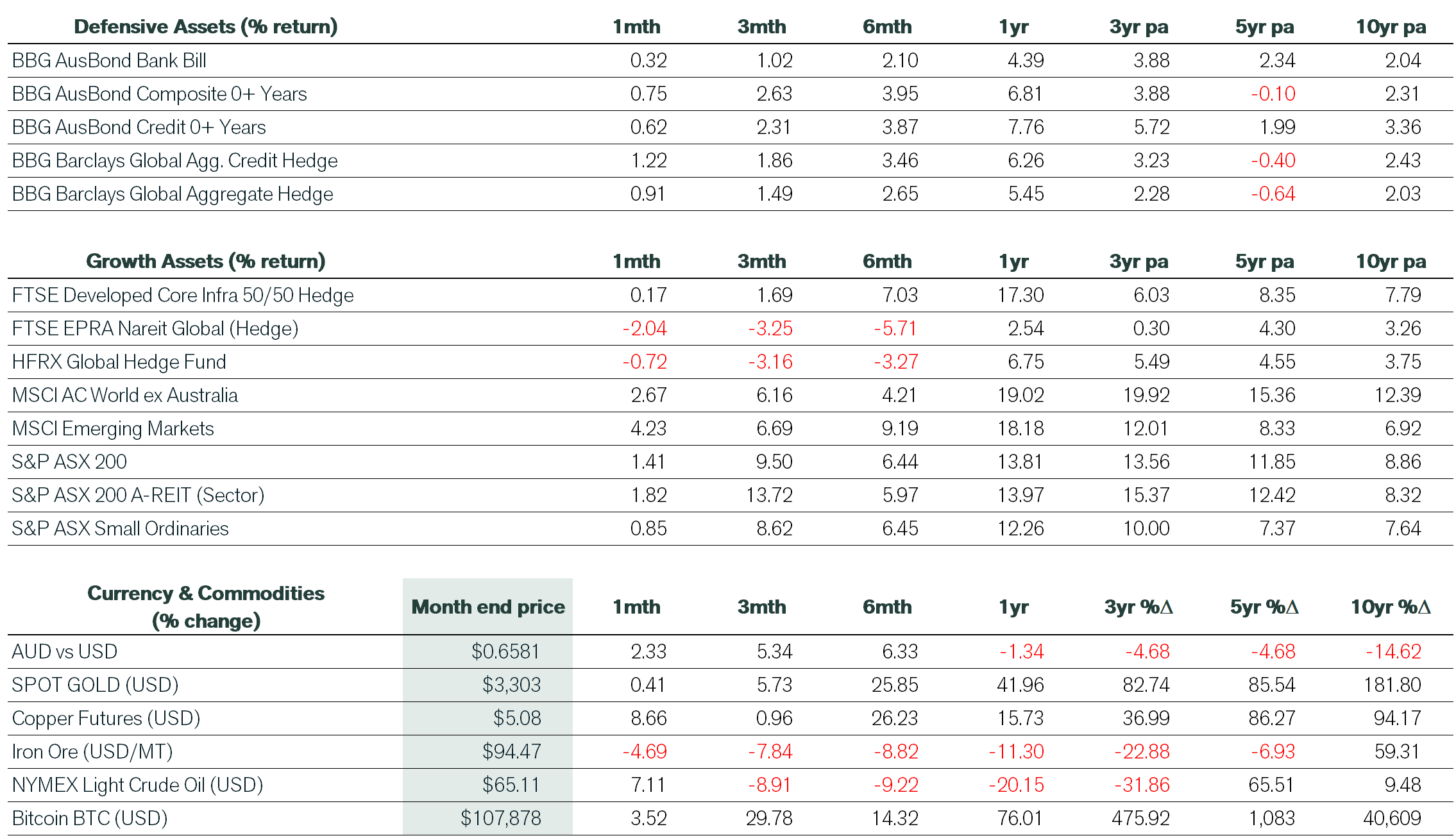June 2025 Economic & Market Review – Strong Markets, Softer Data, and Cautious Central Banks
Talking points
- Stocks hit new highs, even with global tensions: Despite a brief war between Iran and Israel, global stock markets moved higher. Signs of easing trade tensions and improving inflation gave investors reasons to stay optimistic.
- Tech led the rally—again: US markets had a strong month, led by big tech names like Nvidia. Optimism around AI and quantum computing helped the Nasdaq and S&P 500 hit record highs.
- Inflation cooled, and rate cut talk returned: US inflation data came in softer, and markets started pricing in rate cuts as soon as September. Bond yields dropped, and the Fed stayed cautious—but didn’t rule anything out.
- Australia’s economy slowed, but rate pressure eased: Australian inflation surprised to the downside, giving the RBA more room to hold or cut rates. But slower growth and another per capita recession kept the economic outlook mixed.
- Emerging markets gained ground: A weaker US dollar helped emerging markets post solid returns. The MSCI EM index rose 4.2% in June and is ahead of developed markets so far this year.
- Commodities sent a mixed message: Gold lost steam. Iron ore dipped. Oil spiked briefly during the conflict in the Middle East but settled down fast. Crypto, on the other hand, kept climbing.
- Global central banks are going in different directions: The ECB cut rates. The Fed stayed put. The Bank of England held steady but wants more data. In short, interest rate paths are now diverging—adding more complexity for investors.
Market commentary
Despite troubling geopolitical developments, global equities posted strong returns in June, with many indices reaching new all-time highs. Investor optimism grew amid signs of progress in trade negotiations, highlighted by Canada’s decision to scrap its digital services tax targeting US tech firms.
Meanwhile, improving inflation data and weaker prints concerning economic activity saw traders increase bets that the US Federal Reserve (the Fed) would resume its interest rate cutting cycle as soon as September. US Treasury yields fell notably in June, with the 10-year yield dropping by 19 basis points to 4.25%.
The MSCI ACWI ex-Australia index delivered a total return of 2.7% to unhedged domestic investors in June, as a 2.3% appreciation in the Australian dollar blunted global equity returns.
In the US, the benchmark S&P 500 rose nearly 5% over the month and set an all-time high on the final trading day of June. The tech-heavy Nasdaq 100 index gained 6.3%, also reaching record levels, fuelled by robust earnings and optimism around generative AI and quantum computing. Technology stocks led the rally, with Nvidia soaring and regaining its status as the world’s largest company by market capitalisation. A clear trend in 2025 has been US growth stocks outperforming US value stocks. And despite solid performance from US mega cap tech stocks, the value-oriented European banking sector has easily outperformed the Magnificent 7 in 2025.
Elsewhere, the weakness in the US dollar since January has paved the way for stronger returns from emerging markets. The MSCI Emerging Markets index rose 4.2% in June and has outperformed its large cap peers by 5 percentage points this year.
ASX shares finished strongly in June but lagged global peers. The Energy sector was easily the strongest performer over the month, buoyed by a takeover bid for Santos and higher oil prices. The Financial sector had another strong month, helped by further rises in major banking stocks. Commonwealth Bank of Australia (CBA) hit an all-time high of $192 per share on the 25th of June 2025. With an equity market capitalisation in excess of $300 billion and despite limited growth prospects, the stock is now trading at close to 30x earnings and on a 2.5% yield. At the opposite end of the spectrum, the gold miners were significantly weaker in June, as was the broader Materials sector.
Fixed income markets witnessed lower bond yields during the month, reflecting a modest flight to safety amid economic uncertainty and expectations of future central bank rate cuts. The Fed held rates steady at 4.25–4.5%, maintaining a cautious stance, but markets priced in up to three rate cuts by year-end. Yield curves steepened, especially at the long end, due to expectations of increased Treasury supply and ongoing fiscal deficits. Credit spreads stabilised and high-yield credit proved resilient despite geopolitical shocks.
The 12-day war between Iran and Israel caused significant geopolitical volatility. Brent crude jumped to an intraday high of $80 a barrel on the 23rd of June. However, the war had a limited impact on markets after oil prices dropped sharply following the US bombing of Iran’s nuclear facilities.
Elsewhere, precious metals were relatively flat in June, losing momentum after a ceasefire agreement was implemented between Iran and Israel. Iron ore prices were noticeably weaker, while crypto continued its bull run. In contrast, the US dollar index was again weaker due to concerns around the magnitude of Trump’s proposed One Big Beautiful Bill Act.
Economic commentary
Australia
On the economic front, domestic monthly inflation data for May revealed a sharper-than-expected slowdown in consumer price growth, up 2.1% over the year. Market consensus was for CPI expansion to slow to 2.3%.
Meanwhile, trimmed mean inflation – the Reserve Bank of Australia’s preferred measure – came in at 2.4%, down from 2.8%, and just below the midpoint of the RBA’s target inflation band.
Earlier in the month, the national accounts for the March quarter showed that Australia had slipped back into a per capita recession. It was the eighth time in nine quarters that per capita GDP had contracted. Zooming out to the headline figure, quarterly real GDP rose by just 0.2%, versus the consensus estimate of 0.4%. Net exports dragged on the outcome, as did a reduction in government spending.
United States
The Fed cut its outlook for the US economy, with policymakers split on whether they would be able to reduce interest rates this year as the Trump tariffs brought risks of higher inflation. Officials downgraded their estimates for economic growth this year while lifting their forecasts for unemployment and inflation.
In the lead-up to the decision to again pause interest rates, Trump called Fed chairman Jerome Powell “stupid” and asked whether he could “appoint myself” to the central bank. Earlier in the month, annual data for the May headline CPI printed at 2.4%. The Fed’s preferred inflation measure of PCE prices was similar, up 2.3% over the year.
Rest of the world
On the Continent, the ECB cut key interest rates by 25 basis points at its June meeting, as inflation neared the 2% target. Meanwhile, the Bank of England held interest rates steady. The annual inflation rate in the UK edged down to 3.4% in May 2025 and some members of the board are looking for more evidence that inflation will continue its downward trajectory.
In China, core inflation rose 0.6%, marking the highest reading since January, while retail sales showed further signs of recovery.
Pete is the Co-Founder, Principal Adviser and oversees the investment committee for Pekada. He has over 18 years of experience as a financial planner. Based in Melbourne, Pete is on a mission to help everyday Australians achieve financial independence and the lifestyle they dream of. Pete has been featured in Australian Financial Review, Money Magazine, Super Guide, Domain, American Express and Nest Egg. His qualifications include a Masters of Commerce (Financial Planning), SMSF Association SMSF Specialist Advisor™ (SSA) and Certified Investment Management Analyst® (CIMA®).


